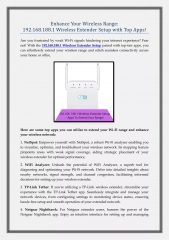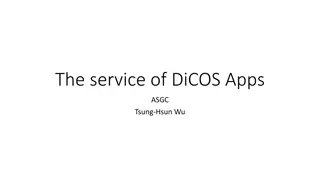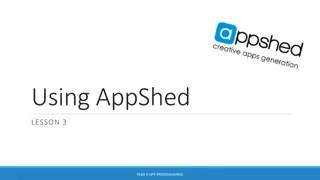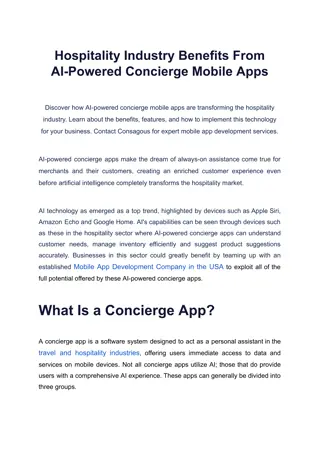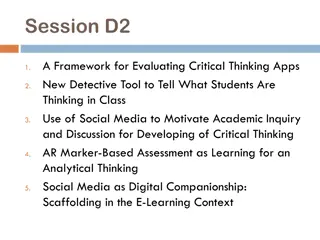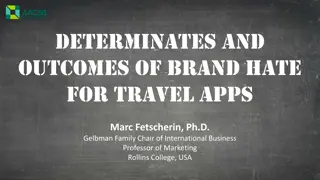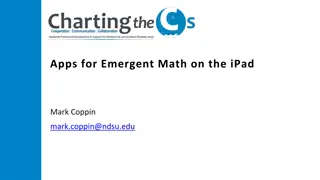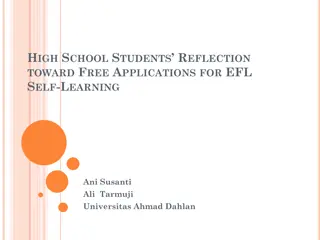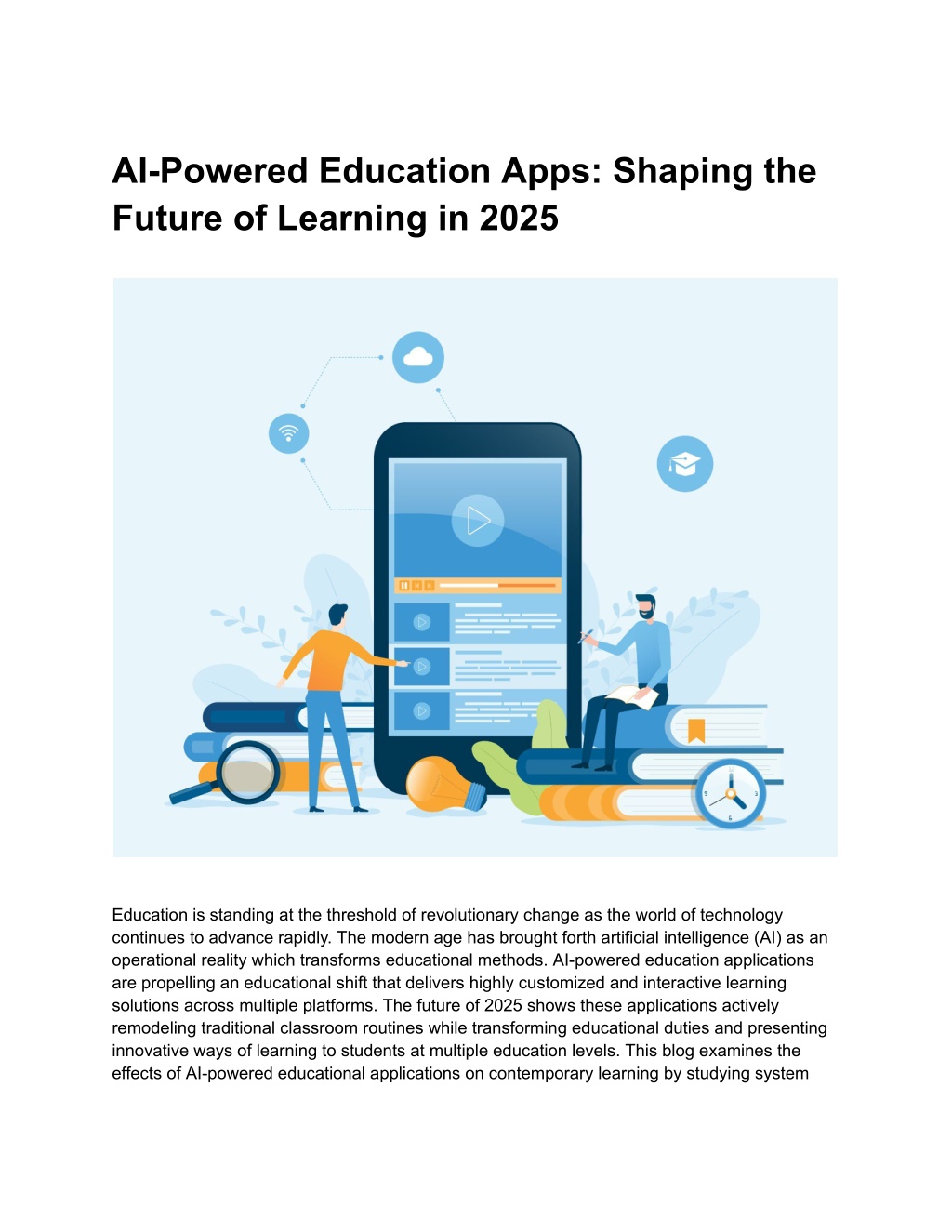
AI-Powered Education Apps: Shaping the Future of Learning in 2025
Artificial Intelligence is revolutionizing the education sector by enabling personalized learning experiences, automating administrative tasks, and enhancing student engagement. This PDF explores how AI-powered education apps are shaping the future o
Download Presentation

Please find below an Image/Link to download the presentation.
The content on the website is provided AS IS for your information and personal use only. It may not be sold, licensed, or shared on other websites without obtaining consent from the author. Download presentation by click this link. If you encounter any issues during the download, it is possible that the publisher has removed the file from their server.
E N D
Presentation Transcript
AI-Powered Education Apps: Shaping the Future of Learning in 2025 Education is standing at the threshold of revolutionary change as the world of technology continues to advance rapidly. The modern age has brought forth artificial intelligence (AI) as an operational reality which transforms educational methods. AI-powered education applications are propelling an educational shift that delivers highly customized and interactive learning solutions across multiple platforms. The future of 2025 shows these applications actively remodeling traditional classroom routines while transforming educational duties and presenting innovative ways of learning to students at multiple education levels. This blog examines the effects of AI-powered educational applications on contemporary learning by studying system
machinery alongside beneficial features and practical accomplishments and technical obstacles alongside future development predictions. The Rise of AI in Education The educational sector has consistently welcomed new technological advancements since the first introduction of chalkboards and the development of internet technology. This digital transformation responds to the leadership position that AI currently holds. AI-enabled applications integrate machine learning along with natural language processing and data analytics so they provide customized learning experiences to individual students. 1. Bridging Gaps and Expanding Access The groundbreaking capability of artificial intelligence in education allows it to connect students who are otherwise isolated. Before modern times students who attended schools in underfunded districts without internet connectivity had restricted access to quality education materials. AI-powered apps provide individuals with top-quality content no matter where they reside. 2. Personalization at Its Best A standard classroom teaching strategy works only once to provide adequate learning support for every student. Each student possesses different abilities together with distinct areas of weakness and personal interests. Machine-learning applications resolve this issue through customized educational directions. The applications apply learning pattern analysis through AI to provide instructional materials that match each student's individual pace as well as chosen learning style. Students achieve independent progression since they can move forward rapidly through easy subjects but focus extra attention on complex topics. 3. Enhanced Engagement Through Interactivity Through the adoption of AI in education systems we have entered an entirely fresh time of interactive education. Traditional static textbooks together with boring lectures have become things of the past. Education applications today provide interactive question systems along with real-time educational feedback which also includes game-oriented learning modules that teach effectively. 4. Supporting Teachers and Educators Artificial Intelligence acts both as a powerful instructional aid for educators while supporting their students. Teachers receive analytical tools which show how each student advances in their studies. The data-driven method enables instructors to locate learning difficulties in their students which leads them to modify their teaching practices properly. Struggling with AI-powered learning apps?Hire AI developers for cutting-edge solutions!
How AI-Powered Education Apps Work The understanding of technological frameworks enables users to recognize why these mobile applications offer valuable results. Complicated algorithms power AI education applications which use large information loads to generate instantaneous teaching decisions and recommendations. 1. Data Collection and Analysis Every Artificial Intelligence system operates through data processing. All student interactions with these apps get recorded through each click and answer and every recorded event. The system evaluates this gathered information to identify how students learn and their current speed alongside their weak points. The app develops comprehensive user profiles through time that enables it to generate personalized learning plans. 2. Machine Learning and Adaptive Learning The essential element in these apps is machine learning technology which drives their operation. The software uses this capability to learn from user interactions which enables it to enhance its recommendation system. Adaptive learning procedures allow content to progress with students during their studies. The application recognizes students who excel at mathematics while having difficulty with language arts thus it modifies its content difficulty and
exercise types to match their learning needs. These learning apps will give students tasks matching their skill level while making sure the challenges are appropriate for their abilities. 3. Natural Language Processing (NLP) The other essential technology involved in education is natural language processing (NLP). Through NLP technology apps gain the ability to decode and translate human speech. Students can use their own language to ask questions which results in understandable responses from the system. NLP technology enables the student-app communication to become more fluid and intuitive by providing explanations and feedback in understandable terms. 4. Interactive Interfaces and Gamification A wide range of modern education applications incorporate user experience concepts in their design as their base technology. The user interfaces are designed for ease of navigation and learning becomes a pleasant experience. Games along with gamification concepts appear in numerous apps through which students experience lessons as they engage in dynamic interactive challenges. The combination of educational enjoyment and exercise completion motivation helps students spend greater time studying the course material. 5. Real-Time Feedback and Continuous Improvement AI provides education with the distinguished advantage of providing rapid feedback to students. Due to AI applications students no longer have to wait lengthy periods to receive grading feedback because they get immediate responses and insights from the system. The real-time feedback system functions as an essential learning tool because it enables students to grasp their errors instantly and build self-assurance for progress. The ongoing data collection activity helps AI programs enhance their algorithms so the learning process continues to improve with time. Traditional learning methods lack engagement? Partner with an AI development company for smart education apps! Key Benefits of AI in Learning The educational system benefits from AI integration through multiple advantages which affect learning at every stage. The following list demonstrates the most important advantages: 1. Personalization and Customization AI-enabled applications evaluate student learning habits to develop personalized educational materials which become known as Tailored Learning Paths. The customized learning approach enables students to concentrate on their weak areas thus improving their educational efficiency.
Students gain control of their education through adaptive learning because they set their own speed of progress. The system allows fast learners to advance but provides enough flexibility for students who need additional time without experiencing any pressure. 2. Increased Engagement The use of AI applications in education enables interactive learning through execution of quizzes and games as well as multimedia features. Our students maintain their attention through this method as well as gaining a simpler understanding of difficult topics. Modern educational apps achieve motivation through gamifying their design by implementing game-based features that reward users and display badges and monitor progress. When learners transform their education into an enjoyable struggle instead of performing homework they dislike learning becomes more appealing to them. 3. Improved Accessibility Modern education programs deploy AI technology to deliver learning opportunities via all devices starting from smartphones and ending with computers and tablets. These learning platforms allow education to accommodate students' locations especially when they are outside traditional educational buildings. NLP advancements enable numerous educational apps to provide language support which enables students from different backgrounds to learn through their native tongues. 4. Enhanced Teacher Support Teachers gain access to comprehensive quality data measurements that let them pinpoint educational weak points as well as modify instructional strategies. The grading process and response feedback generation from AI solutions both reduce time requirements for teachers because of their automated functions. 5. Continuous Improvement The learning path stays effective and relevant because students interact with the app where AI continually refines its recommendations. AI apps maintain up-to-date content through their access to extensive information databases which allows students to receive both modern and precise educational material. The advantages demonstrate that AI education platforms represent a permanent transformation in educational systems despite popular beliefs. These educational apps offer two essential benefits which make them vital digital tools for current educational practices. Also Read: Top AI App Ideas
Real-World Applications and Success Stories Artificial Intelligence enables educational transformations which students and teachers experience inside classrooms and homes across the world. The following section presents genuine examples together with successful implementations of AI-based educational applications. 1. Adaptive Learning Platforms Educational institutions alongside schools everywhere have implemented AI-powered adaptive learning systems for their teaching operations. The platforms maintain ongoing student performance assessment before adapting curriculum content based on individual learning needs. The educational system provides students who have difficulty with algebra extended practice assignments and detailed explanation sequences until they understand the subject matter. Electronic learning platforms present scholarly students with harder material to maintain their academic motivation. The specific learning approach at schools leads to better student test performance together with greater educational satisfaction records. 2. Language Learning Apps Advanced language learning technology now reconstructs the field through AI-powered software applications. By applying speech recognition and NLP capabilities these tools enable students to develop both pronunciation skills along with better grammar skills. Users can interact through conversations with the app which gives them instant feedback and allows them to join virtual language exchange sessions. The language learning applications have gained recognition from students because they create flexible environments which match individual proficiency levels. Learning a new language becomes more efficient while participants build stronger confidence in their abilities when speaking it. 3. STEM Education Enhancement STEM subjects which include science technology engineering and mathematics demonstrate significant improvements because of artificial intelligence integration. Automation-powered educational software delivers simulated environments together with virtual lab experiences alongside interactive solutions that simplify challenging scientific learning material. The new technology enables students to practice chemistry experiments with safety features to immediately observe results thus improving students' understanding and their ability to keep the material in their minds. The practical method of teaching has increased student participation in STEM subjects among younger generations. 4. Special Education and Inclusivity AI demonstrates its most encouraging educational value through its work in special education. AI applications feature student-specific content adaptation which produces learning materials
that meet special educational needs of each learner. The apps include features which allow users to modify font sizes while offering voice guidance and interactive exercises made for students with disabilities. 5. Lifelong Learning and Professional Development School education does not represent the only place where learning takes place. More professionals now select AI-based education apps to enhance their competence and make career transitions. The educational apps deliver lessons across programming and digital advertising topics and they allow students to study according to their personal schedules. Poor user engagement in learning apps? Partner with a top mobile app development company! Challenges and Ethical Considerations Both sides of AI educational app adoption present clear benefits which need to overcome various implementation obstacles. Technological systems require proper risk management to establish fair learning environments. 1. Data Privacy and Security AI applications need users to provide extensive data for their operation. The system collects three types of information which include personal details and learning patterns as well as academic performance records. The storage and ethical use of this data requires the highest priority. Schools and policymakers together with app developers need to establish comprehensive data protection systems which receive support from all these institutions. Students and their parents and educators need to trust educational systems so schools must provide strong privacy guidelines together with explicit user consent agreements. 2. Digital Divide All students cannot benefit equally from AI educational applications because they lack the required technical equipment. The gap between digital access poses a major challenge because it affects primarily remote rural regions along with places lacking proper resources. Education democratization through AI requires active work to provide every student with needed devices and internet access to fully use these innovative learning methods. 3. Over-Reliance on Technology Data shows that excessive dependence on technology may diminish the interpersonal connections during teaching and learning sessions. The supportive and interpersonal capabilities which teachers deliver through empathy and mentorship stay beyond the reach of AI
capabilities. An optimal educational space should unite technology with human interaction instead of creating a situation where one element dominates the other. 4. Bias in Algorithms AI systems demonstrate the same level of accuracy as the quality of data fed into their training process. These programs could inadvertently keep biases from their training information that led to their development. Developers of apps need to guarantee continuous audits for algorithm fairness along with utilizing various datasets which reduce bias. The understanding of system operations by educators and parents becomes possible through transparent system explanations. Future Trends: The Path Ahead AI in education shows evidence of growing in importance across future timeframes. Several educational traits will shape the way we learn both in 2025 and afterward. 1. Greater Integration of Virtual Reality (VR) and Augmented Reality (AR) Students will experience virtual learning by using interactive three-dimensional historical artifacts and layer-by-layer human body models and complex physics laboratories directly from home without leaving their living space. Through the combination of AI technology with VR and AR we will experience vivid educational simulations which represent difficult concepts for better understanding. 2. Increased Collaboration Between Human Educators and AI AI functions as a partner of educators to establish advanced learning platforms. AI systems execute mundane responsibilities for grading assignments and customized comments to enable instructors to nurture critical thinking as well as emotional intelligence and creativity in students. The combined efforts between humans and technology will produce classrooms which utilize technology to amplify human interaction rather than eliminate it. 3. Expansion of Lifelong Learning Platforms Formal education no longer represents the sole concept of education. AI-powered platforms will develop significantly to deliver learning resources for all those who want to study including both professionals and hobby enthusiasts and people interested in self-improvement. The evolving approach to lifelong learning makes education into an uninterrupted development path that helps both job transitions and individual advancement from cradle to grave.
4. Enhanced Global Learning Communities The power of AI-based applications links students worldwide to establish interactive learning environments that exchange ideas together with cultural learnings and academic information. The sudden intelligence-improved communities will increase student learning depth while enabling global knowledge exchanges for better international relations. 5. Smarter Content Creation and Curation The content of tomorrow will be adaptable based on specific learner requirements. AI systems will both find appropriate educational materials and generate new high-quality educational content for students. Multimedia processing together with natural language generation technologies will enable students to access updated learning content that is engaging. Must Read: Top AI Trends to Look in Future Conclusion AI-powered education apps will lead the bright educational future of 2025 by designing this new learning environment. Such educational applications dismantle traditional learning restrictions because they provide adaptable and individualized instructional programs with interactive learning materials which make education both entertaining and easy to reach. The educational landscape faces an active transformation through AI-powered education applications which serve as catalysts for developing a new era of learning. Such learning tools introduce a student-centered system which combines personalization with accessible education through engaging content to help all groups affected by education. Building a future society where education reaches every person becomes essential by accepting these technologies during the period between 2025 and beyond to unleash innovation and unlock individual potential. Original Source: https://www.globalblogzone.com/ai-powered-education-apps-shaping-the-future-of-learni ng/


